

INVENTARIO DI UNA MEMORIA DIMENTICATA
The house, in its original form of dwelling, can resemble a shell, as Walter Benjamin recalled in The Passages of Paris; a compass case in which the instrument is set in deep velvet grooves, and everything is safe, in its place. A space strong in its being limited, whose geometric boundaries distinguish what is the interior space, constituted by the house, from the exterior space, that is, everything that is not occupied by it. The house is therefore a welcoming case that, like Chance's garden, the character from the novel Being There by Jerzy Kosinski, 'allows one to move within their own time,' ignoring the streets outside and remaining safe.
Yet, by its very configuration, the house presents a dialectical element where the inside and outside come into contact: the windows. Points where the boundary thins, becoming transparent and sometimes almost absent behind a curtain or mosquito net. For that moment when one looks outside, for that instant when the window is open, the lurking outside prepares to enter, bursting into the soft opacity of the rooms of the house, but it cannot cross the threshold completely and remains there in its constant and lively micro-changes, but always on the other side.
Photographer: Sofia Cambiaggio — Graphic designer: Sofia Cambiaggio — Supervisor: Leonardo Sonnoli, Paola De Pietri — Font: Lausanne 300 © TYPE WELTKERN — Print: ISIA Urbino — ISIA U 2024
Incomplete Itinerary – 24 contemporary churches in Lombardy is an editorial project that brings together the work of 12 Photography students from the Architecture Photography course at ISIA U, attempting to investigate through images the notable works of architects in the cities of Milan, Varese, and Pavia. The project outlines an itinerary aimed at leading to a path that is not purely ordinary. I documented the Church of San Gerolamo Emiliani built in the Cimiano neighborhood within the city of Milan, designed by the architect Carlo De Carli; and the Church of San Francesco d'Assisi built in the INA district of Cesate (MI), designed by the architect Ignazio Gardella. In the exhibition hosted at the Rumore ISIA U space (Via V. Veneto 64-66, Urbino, PU) and in the editorial project, the journey is guided by a geographical map that locates the ecclesiastical buildings in the three explored areas, describing the incomplete itinerary to follow.
Photographer: Sofia Cambiaggio — Editorial project + Exhibition: Matteo Mariangioli & Aurora Pelaggi — Supervisor: Alberto Sinigaglia — Font: Walter, Normal Grotesque © ABC Dynamo — Print: ISIA Urbino — ISIA U 2023
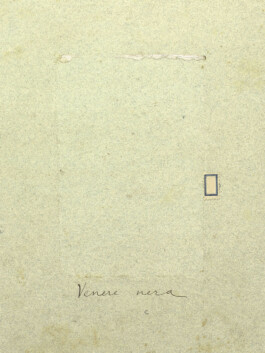
The IsIAO colonial archive, originating from the former Colonial Museum under the Ministry of the Colonies, is preserved in the National Central Library of Rome and is considered one of the most extensive visual records of Italian colonialism. Despite the abundance of documents, however, collective awareness of Italy's colonial past is non-existent.
These archives serve as concrete evidence of how it is possible to forget, even through memory. The photographs in this collection are preserved in albums and accompanied by captions from that era. Far from being objective descriptions, these are instead projections of a colonial, Western mindset, steeped in supremacism and racialization. They do not help us understand; rather, they expose us.
INVENTARIO DI UNA MEMORIA DIMENTICATA addresses the need to confront these archives. A selection of captions from three albums, dated 1895, 1910, and 1937, is bound in a specially made volume. The images are not shown, to avoid reiterating violence. Instead, the viewer is invited to imagine it, focusing on the language and the mindset that expresses it. The only visual exception in the project is the image of a "tear," an enlargement of a page from the 1895 album that serves as a trace of an absence. The installation consists of an audio loop in which the author describes each image in the first person, observing its constituent elements in an attempt to reconstruct the truth of the scenes, in contrast to the colonial description. The only exception, also on the auditory level, is the torn image, with which the voice engages in search of a deeper connection. During the exhibition "Positioning Practices", pamphlet versions of the volume were displayed, made available to those in the audience who wished to return and reflect independently on the proposed contents.
The project has been included in the publication Pratiche di posizionamento | Indagini sull’esperienza coloniale italiana tra memoria e presente, published by Corraini Edizioni.
Author: Sofia Cambiaggio — Voice: Sofia Cambiaggio — Curators: Luca Capuano, Matteo Guidi, Alessandro Carrer, Armin Linke, Allison Mistura – Place: Villa Romana, Firenze – dal 12.07 al 12.08, 2024.
The IsIAO colonial archive, originating from the former Colonial Museum under the Ministry of the Colonies, is preserved in the National Central Library of Rome and is considered one of the most extensive visual records of Italian colonialism. Despite the abundance of documents, however, collective awareness of Italy's colonial past is non-existent. These archives serve as concrete evidence of how it is possible to forget, even through memory. The photographs in this collection are preserved in albums and accompanied by captions from that era. Far from being objective descriptions, these are instead projections of a colonial, Western mindset, steeped in supremacism and racialization. They do not help us understand; rather, they expose us.
These archives serve as concrete evidence of how it is possible to forget, even through memory. The photographs in this collection are preserved in albums and accompanied by captions from that era. Far from being objective descriptions, these are instead projections of a colonial, Western mindset, steeped in supremacism and racialization. They do not help us understand; rather, they expose us.
INVENTARIO DI UNA MEMORIA DIMENTICATA addresses the need to confront these archives. A selection of captions from three albums, dated 1895, 1910, and 1937, is bound in a specially made volume. The images are not shown, to avoid reiterating violence. Instead, the viewer is invited to imagine it, focusing on the language and the mindset that expresses it. The only visual exception in the project is the image of a "tear," an enlargement of a page from the 1895 album that serves as a trace of an absence. The installation consists of an audio loop in which the author describes each image in the first person, observing its constituent elements in an attempt to reconstruct the truth of the scenes, in contrast to the colonial description. The only exception, also on the auditory level, is the torn image, with which the voice engages in search of a deeper connection. During the exhibition "Positioning Practices", pamphlet versions of the volume were displayed, made available to those in the audience who wished to return and reflect independently on the proposed contents.
The project has been included in the publication Pratiche di posizionamento | Indagini sull’esperienza coloniale italiana tra memoria e presente, published by Corraini Edizioni.
Author: Sofia Cambiaggio — Voice: Sofia Cambiaggio — Curators: Luca Capuano, Matteo Guidi, Alessandro Carrer, Armin Linke, Allison Mistura – Place: Villa Romana, Firenze – dal 12.07 al 12.08, 2024.
Starting from a selection of videos of Italian post-war newsreels, preserved and offered to us by Archivio Istituto Luce, the video reflects on the paradox of media narratives related to the theme of 'bad weather' in the history of Italy.
Based on reports from Settimana Incom, Il picnic è stato rinviato per via del maltempo sheds light on the paradox of communication about bad weather, especially after the recent climatic events. Mainstream narratives often have a very dramatic tone of voice but use a basic, sparse communication style that provides no actual information other than the mere news report and lacks any assumption of responsibility, such as would be implied by the term "climate crisis".
Like a digital interface, archival windows open on a screen while a voice comments on events from today and yesterday: these are words written by journalist Antonio Cederna in several articles published between 1972 and 1988. What was referred to as 'bad weather' back then should today be called "climate crisis". However, it seems that little progress has been made.
This video is being presented at the 17th edition of Archivio Aperto (2024) in Bologna, in the out-of-competition screening 'Lezioni d'Archivio – INCOMbenze' on October 25th.
Subject: Sofia Cambiaggio & Beatrice Vincenti — Editing and direction: Sofia Cambiaggio & Beatrice Vincenti — Voice: Mohammad Mahameed — Video Copyright: Istituto Luce – Supervisors: Milo Adami, Alessandro Carrer
Starting from a selection of videos of Italian post-war newsreels, preserved and offered to us by Archivio Istituto Luce, the video reflects on the paradox of media narratives related to the theme of 'bad weather' in the history of Italy.
Based on reports from Settimana Incom, Il picnic è stato rinviato per via del maltempo sheds light on the paradox of communication about bad weather, especially after the recent climatic events. Mainstream narratives often have a very dramatic tone of voice but use a basic, sparse communication style that provides no actual information other than the mere news report and lacks any assumption of responsibility, such as would be implied by the term "climate crisis".
Like a digital interface, archival windows open on a screen while a voice comments on events from today and yesterday: these are words written by journalist Antonio Cederna in several articles published between 1972 and 1988. What was referred to as 'bad weather' back then should today be called "climate crisis". However, it seems that little progress has been made.
This video is being presented at the 17th edition of Archivio Aperto (2024) in Bologna, in the out-of-competition screening 'Lezioni d'Archivio – INCOMbenze' on October 25th.
Subject: Sofia Cambiaggio & Beatrice Vincenti — Editing and direction: Sofia Cambiaggio & Beatrice Vincenti — Voice: Mohammad Mahameed — Video Copyright: Istituto Luce – Supervisors: Milo Adami, Alessandro Carrer
Photographer: Sofia Cambiaggio — Editing and direction: Sofia Cambiaggio — Supervisor: Erik Kessels — ISIA U 2023
My father never told me much about his past.
Recently I found an old photo album of his. It turned out that when he was young, he took a picture from
a window of our house in Milan. Over the years I have taken the same picture several times...
So I decided to talk to him.
That window is a project that addresses a personal theme and was created during a workshop called 'Come to See My Backyard' led by Erik Kessels in November 2023 at ISIA of Urbino. We were invited to try to show something from our backyard, meaning that place, that part of ourselves that is usually hidden, personal, and often not shown because it causes us embarrassment or pain.
My father never told me much about his past.
Recently I found an old photo album of his. It turned out that when he was young, he took a picture from
a window of our house in Milan. Over the years I have taken the same picture several times...
So I decided to talk to him.
That window is a project that addresses a personal theme and was created during a workshop called 'Come to See My Backyard' led by Erik Kessels in November 2023 at ISIA of Urbino. We were invited to try to show something from our backyard, meaning that place, that part of ourselves that is usually hidden, personal, and often not shown because it causes us embarrassment or pain.
Photographer: Sofia Cambiaggio — Editing and direction: Sofia Cambiaggio — Supervisor: Erik Kessels — ISIA U 2023
Geografia di una corrispondenza is an attempt to map the space of the Trabucchi of Vieste, structures with a strong local identity intertwined with the natural territory, which, however, risk losing their uniqueness due to mass tourism. My goal was not to obtain a scientific description but rather to understand these spaces and relate to them using the anthropological approach that Tim Ingold proposes in his book Correspondences.
It was an effort to recognize, through suggestions made up of images and words, questions, and new points of view, this sense of correspondence, connection, and precariousness typical of a boundary space between solid and liquid, between land and sea.
Photographer: Sofia Cambiaggio — Author: Sofia Cambiaggio – Editorial project: Christian Stifani & Sofia Cambiaggio – Font: Sohne Kraftig © Klim Type Foundry — Print: ISIA Urbino — ISIA U 2024
Geografia di una corrispondenza is an attempt to map the space of the Trabucchi of Vieste, structures with a strong local identity intertwined with the natural territory, which, however, risk losing their uniqueness due to mass tourism. My goal was not to obtain a scientific description but rather to understand these spaces and relate to them using the anthropological approach that Tim Ingold proposes in his book Correspondences.
It was an effort to recognize, through suggestions made up of images and words, questions, and new points of view, this sense of correspondence, connection, and precariousness typical of a boundary space between solid and liquid, between land and sea.
Photographer: Sofia Cambiaggio — Author: Sofia Cambiaggio – Editorial project: Christian Stifani & Sofia Cambiaggio – Font: Sohne Kraftig © Klim Type Foundry — Print: ISIA Urbino — ISIA U 2024
Audio-description of captions
traccia audio 01
traccia audio 02
traccia audio 03
traccia audio 04
traccia audio 05
traccia audio 06
traccia audio 07
traccia audio 08
traccia audio 09
traccia audio 10
traccia audio 11
traccia audio 12
traccia audio 13
traccia audio 14
traccia audio 15
traccia audio 16
traccia audio 17
traccia audio 18
traccia audio 19
traccia audio 20
traccia audio 21
traccia audio 23
traccia audio 24
traccia audio 25
traccia audio 26
traccia audio 27
traccia audio 28
traccia audio 29
traccia audio 30
traccia audio 31
traccia audio 32
traccia audio 33
traccia audio 34
traccia audio 35
traccia audio 36
traccia audio 37
traccia audio 38
traccia audio 39
traccia audio 40
traccia audio 41
traccia audio 42
traccia audio 43
traccia audio 44
traccia audio 45
traccia audio 46
traccia audio 47
traccia audio 48
traccia audio 49
traccia audio 50
traccia audio 51
traccia audio 52
traccia audio 53
traccia audio 54
traccia audio 55
traccia audio 56
traccia audio 57
traccia audio 58
traccia audio 01
traccia audio 02
traccia audio 03
traccia audio 04
traccia audio 05
traccia audio 06
traccia audio 07
traccia audio 08
traccia audio 09
traccia audio 10
traccia audio 11
traccia audio 12
traccia audio 13
traccia audio 14
traccia audio 15
traccia audio 16
traccia audio 17
traccia audio 18
traccia audio 19
traccia audio 20
traccia audio 21
traccia audio 22
traccia audio 23
traccia audio 24
traccia audio 25
traccia audio 26
traccia audio 27
traccia audio 28
traccia audio 29
traccia audio 30
traccia audio 31
traccia audio 32
traccia audio 33
traccia audio 34
traccia audio 35
traccia audio 36
traccia audio 37
traccia audio 38
traccia audio 39
traccia audio 40
traccia audio 41
traccia audio 42
traccia audio 43
traccia audio 44
traccia audio 45
traccia audio 46
traccia audio 47
traccia audio 48
traccia audio 49
traccia audio 50
traccia audio 51
traccia audio 52
traccia audio 53
traccia audio 54
traccia audio 55
traccia audio 56
traccia audio 57
traccia audio 58
What is the sea? A place, a natural element, a line on the horizon, or simply an idea? Perhaps the idyll of vacation, the fresh air, the warmth, the sun, and the beautiful views of a vast expanse of blue water suggest to us that the sea is first and foremost imaginary.
Hotel Bellevue is a small research project, born out of a morning walk along the coast of Pesaro, in a desperate attempt to see the sea.
Like in a discussion where the subject is never explicitly stated, but simply outlined with a series of allusions, the pedestrian belvedere on the seafront of Pesaro presented itself to my eyes as the perfect stage for one of Italy's most well-constructed imaginaries: the maritime one. An imaginary where, however, the Sea, the one made of water, seems to barely reveal itself while traversing the kilometers of promenade.
Photographer: Sofia Cambiaggio — Graphic designer: Sofia Cambiaggio — Supervisor: Luca Capuano — Font: ABC Diatype © ABC Dinamo — ISIA U 2023
What is the sea? A place, a natural element, a line on the horizon, or simply an idea? Perhaps the idyll of vacation, the fresh air, the warmth, the sun, and the beautiful views of a vast expanse of blue water suggest to us that the sea is first and foremost imaginary.
Hotel Bellevue is a small research project, born out of a morning walk along the coast of Pesaro, in a desperate attempt to see the sea.
Like in a discussion where the subject is never explicitly stated, but simply outlined with a series of allusions, the pedestrian belvedere on the seafront of Pesaro presented itself to my eyes as the perfect stage for one of Italy's most well-constructed imaginaries: the maritime one. An imaginary where, however, the Sea, the one made of water, seems to barely reveal itself while traversing the kilometers of promenade.
Photographer: Sofia Cambiaggio — Graphic designer: Sofia Cambiaggio — Supervisor: Luca Capuano — Font: ABC Diatype © ABC Dinamo — ISIA U 2023
S.Ciro Display is the result of a week-long residency in Atena Lucana (SA) promoted by Archivio Atena and centered around the concept of the Census.
Through interactions with the locals in Atena Lucana, site of a miracle attributed to S. Ciro, I discovered that in this place, faith seeks tangible signs, and the truth of faith is conveyed through staging: the procession is a simulation, the reenactment is a theatrical representation, votive objects become part of a set, and the site of the miracle becomes the stage.
The care for these places and rituals is a tangible gesture of devotion to the Saint.
In my project, I mapped the route of the procession of S. Ciro through a sequence of shots taken by carrying the camera at shoulder height, simulating the movements of the statue when carried by the faithful.
I then reconstructed, in six shots, the floor plan of the chapel of S. Nicola where the miraculous event occurred and produced a series of photographs of the Sanctuary of S. Ciro, inside of which objects and furnishings were wrapped in plastic sheets to protect them during renovation work. Finally, I aimed to construct a visual atlas of votive and devotional objects dedicated to the saint and photographed the chronicle of the miracle, framed and hung in the Pilgrim's Room adjacent to the sanctuary. All these interventions converge in defining a single display that aims to provide a collective view of devotion actively constructed by an entire community through its places, gestures, and rituals.
Photographer: Sofia Cambiaggio — Graphic designer: Roberto Lenza — Supervisors: Luca Capuano e Alessandro Imbriaco — Print: Skillpress — ISIA U 2023
S.Ciro Display is the result of a week-long residency in Atena Lucana (SA) promoted by Archivio Atena and centered around the concept of the Census.
Through interactions with the locals in Atena Lucana, site of a miracle attributed to S. Ciro, I discovered that in this place, faith seeks tangible signs, and the truth of faith is conveyed through staging: the procession is a simulation, the reenactment is a theatrical representation, votive objects become part of a set, and the site of the miracle becomes the stage.
The care for these places and rituals is a tangible gesture of devotion to the Saint.
In my project, I mapped the route of the procession of S. Ciro through a sequence of shots taken by carrying the camera at shoulder height, simulating the movements of the statue when carried by the faithful.
I then reconstructed, in six shots, the floor plan of the chapel of S. Nicola where the miraculous event occurred and produced a series of photographs of the Sanctuary of S. Ciro, inside of which objects and furnishings were wrapped in plastic sheets to protect them during renovation work. Finally, I aimed to construct a visual atlas of votive and devotional objects dedicated to the saint and photographed the chronicle of the miracle, framed and hung in the Pilgrim's Room adjacent to the sanctuary. All these interventions converge in defining a single display that aims to provide a collective view of devotion actively constructed by an entire community through its places, gestures, and rituals.
Photographer: Sofia Cambiaggio — Graphic designer: Roberto Lenza — Supervisors: Luca Capuano e Alessandro Imbriaco — Print: Skillpress — ISIA U 2023
Museums are full of faces and figures. I'm not just talking about paintings or official artworks, but also all those representations that are part of the museum context, such as architectural decorations like those found in the Palazzo Ducale of Urbino, for example.
In a moment of distraction from the planned visit to the galleries, I found myself observed by a thousand 'little faces', which seemed to follow me with their sight, talk to me, and suggest things with their facial and bodily expressions. So I decided to follow them...
Così vive e animate is like a game – dreamlike and ironic at the same time – which explores the theme of animated statues in myth, theater, and ancient and modern literature. It builds analogies and relationships between photographs and texts with the intention of prompting a mechanism of free association and imagination.
Photographer: Sofia Cambiaggio — Graphic designer: Sofia Cambiaggio — Supervisor: Leonardo Sonnoli — Font: Akzidenz-Grotesk Pro © Berthold Type Foundry — Print: ISIA Urbino — ISIA U 2023
Museums are full of faces and figures. I'm not just talking about paintings or official artworks, but also all those representations that are part of the museum context, such as architectural decorations like those found in the Palazzo Ducale of Urbino, for example.
In a moment of distraction from the planned visit to the galleries, I found myself observed by a thousand 'little faces', which seemed to follow me with their sight, talk to me, and suggest things with their facial and bodily expressions. So I decided to follow them...
Così vive e animate is like a game – dreamlike and ironic at the same time – which explores the theme of animated statues in myth, theater, and ancient and modern literature. It builds analogies and relationships between photographs and texts with the intention of prompting a mechanism of free association and imagination.
Photographer: Sofia Cambiaggio — Graphic designer: Sofia Cambiaggio — Supervisor: Leonardo Sonnoli — Font: Akzidenz-Grotesk Pro © Berthold Type Foundry — Print: ISIA Urbino — ISIA U 2023
Arrivederci e grazie is an experimental project that explores the receipt as a ready-made object and exploits the physical-chemical characteristics of thermal printing to investigate its material and generative potential. The act of anomalous darkening the paper by using different heat sources had created unexpected figures. Through observation, these figures take on unique meanings and interpretations. When shapes are completely abstract, our minds try to impose a meaningful interpretation even in the face of ambiguity, leading individuals to expand their perception creating an imaginary universe full of figures. This phenomenon is called pareidolia.
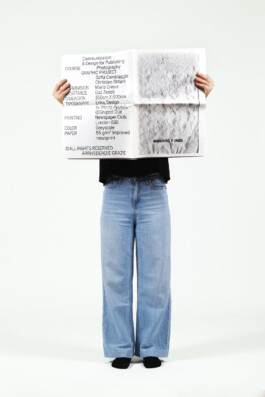
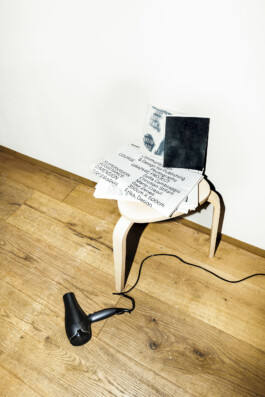
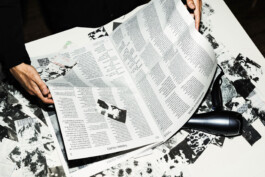
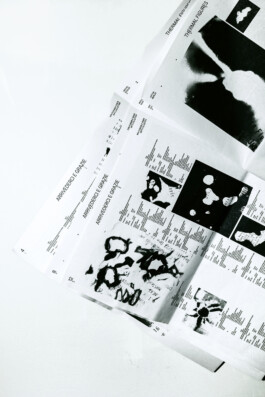

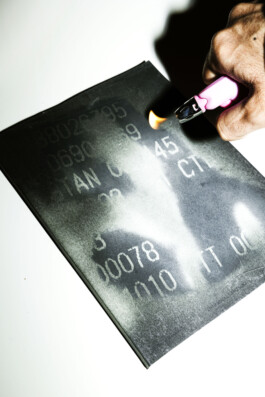
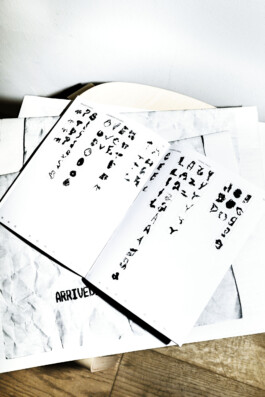
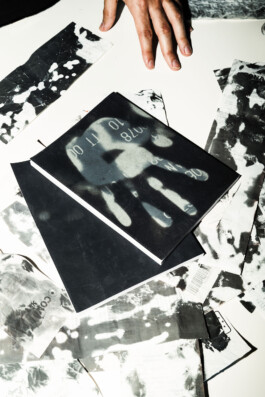
The receipt undergoes a transformation from a purely functional item, breaking into unique figures and signs due to consumer practices. The project includes a newspaper and an experimental insert with thermochromic ink on the cover. The first focuses on potential figures from darkening, while the second emphasizes lettering generated similarly, with attention to letters as visual signs. Reflection expands into NFTs through image processing from darkening, attributing value to each original digital token. This process serves as a pretext to turn the receipt from a disposable document into a precious digital art object.
Photographer: Sofia Cambiaggio — Graphic designer: Christian Stifani — Supervisor: Mario Cresci — Font: Erika Design by Moritz Appich © Gruppo Due — Print: Newspaper Club, London & ISIA Urbino — ISIA U 2023
Arrivederci e grazie is an experimental project that explores the receipt as a ready-made object and exploits the physical-chemical characteristics of thermal printing to investigate its material and generative potential. The act of anomalous darkening the paper by using different heat sources had created unexpected figures. Through observation, these figures take on unique meanings and interpretations. When shapes are completely abstract, our minds try to impose a meaningful interpretation even in the face of ambiguity, leading individuals to expand their perception creating an imaginary universe full of figures. This phenomenon is called pareidolia.
The receipt undergoes a transformation from a purely functional item, breaking into unique figures and signs due to consumer practices. The project includes a newspaper and an experimental insert with thermochromic ink on the cover. The first focuses on potential figures from darkening, while the second emphasizes lettering generated similarly, with attention to letters as visual signs. Reflection expands into NFTs through image processing from darkening, attributing value to each original digital token. This process serves as a pretext to turn the receipt from a disposable document into a precious digital art object.
Photographer: Sofia Cambiaggio — Graphic designer: Christian Stifani — Supervisor: Mario Cresci — Font: Erika Design by Moritz Appich © Gruppo Due — Print: Newspaper Club, London & ISIA Urbino — ISIA U 2023
Incomplete Itinerary – 24 contemporary churches in Lombardy is an editorial project that brings together the work of 12 Photography students from the Architecture Photography course at ISIA U, attempting to investigate through images the notable works of architects in the cities of Milan, Varese, and Pavia. The project outlines an itinerary aimed at leading to a path that is not purely ordinary. I documented the Church of San Gerolamo Emiliani built in the Cimiano neighborhood within the city of Milan, designed by the architect Carlo De Carli; and the Church of San Francesco d'Assisi built in the INA district of Cesate (MI), designed by the architect Ignazio Gardella.
In the exhibition hosted at the Rumore ISIA U space (Via V. Veneto 64-66, Urbino, PU) and in the editorial project, the journey is guided by a geographical map that locates the ecclesiastical buildings in the three explored areas, describing the incomplete itinerary to follow.
Photographer: Sofia Cambiaggio — Editorial project + Exhibition: Matteo Mariangioli & Aurora Pelaggi — Supervisor: Alberto Sinigaglia — Font: Walter, Normal Grotesque © ABC Dynamo — Print: ISIA Urbino — ISIA U 2023
Incomplete Itinerary – 24 contemporary churches in Lombardy is an editorial project that brings together the work of 12 Photography students from the Architecture Photography course at ISIA U, attempting to investigate through images the notable works of architects in the cities of Milan, Varese, and Pavia. The project outlines an itinerary aimed at leading to a path that is not purely ordinary. I documented the Church of San Gerolamo Emiliani built in the Cimiano neighborhood within the city of Milan, designed by the architect Carlo De Carli; and the Church of San Francesco d'Assisi built in the INA district of Cesate (MI), designed by the architect Ignazio Gardella. In the exhibition hosted at the Rumore ISIA U space (Via V. Veneto 64-66, Urbino, PU) and in the editorial project, the journey is guided by a geographical map that locates the ecclesiastical buildings in the three explored areas, describing the incomplete itinerary to follow.
Photographer: Sofia Cambiaggio — Editorial project + Exhibition: Matteo Mariangioli & Aurora Pelaggi — Supervisor: Alberto Sinigaglia — Font: Walter, Normal Grotesque © ABC Dynamo — Print: ISIA Urbino — ISIA U 2023
Sofia Cambiaggio is an artist born (2000, Italy) and raised in Milan. Working predominantly with photography and graphic she explores different media like installations, video and editorial displays. She is now attending a MA Photography at ISIA Urbino.
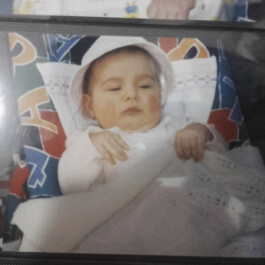
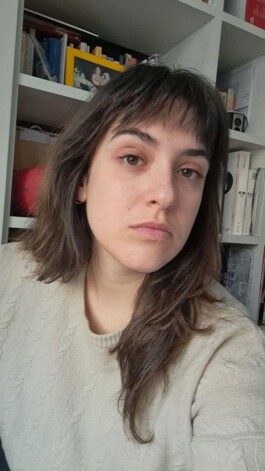

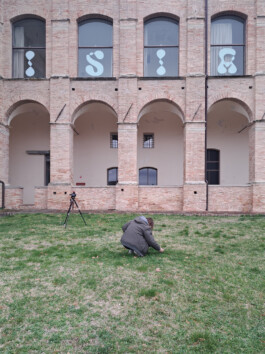
FACT-BASED BIOGRAPHY
EDUCATION
[MA]2022–/ Photography – ISIA Urbino
[BA]2019–22 Communication Design – Politecnico di Milano
WORKSHOP+TALK
[T]2024 Making Visible the Invisible. Body, Archive and Resistance – Angelica Pesarini
[T]2024 Museo delle opacità – Matteo Lucchetti
[W]2023 Come to see my backyard – Erik Kessels
[W]2023 Counter-surveillance – Adam Broomberg
[T]2023 Immagini e Processi: per una sperimentazione tecnica e concettuale – Giorgio Di Noto
[W]2023 Re-reading the museum – Joan Fontcuberta
[W]2023 Incontrare gli archivi nel mezzo della ricerca comunitaria – Viviana Gravano, Maria Thereza Alvez
[W]2023 Index Naturae. Il Libro Dei Libri – Stefania Rossl, Massimo Sordi (OMNE)
[W]2023 Fotografo quindi stampo – Antonio Manta
[W]2022 Unsafe Game – Politecnico di Milano, ATS Insubria
EXHIBITION+SCREENING
[S]2024 Archivio Aperto 17th edition, Lezioni d'archivio: INCOMbenze – Ex Chiesa di San Mattia, Bologna
[E]2024 Positioning Practices – Villa Romana, Firenze
[E]2023 Incomplete Itinerary. 24 contemporary churches in Lombardy – Spazio Rumore ISIA U, Urbino
[E]2023 INVENTARIO, Archivio Atena – Atena Lucana
[E]2023 Camere con vista. San Benedetto/Pesaro. Andata e ritorno – Rocca Roveresca, Senigallia
[E]2023 I frammenti e il tutto: Catalogo in Catalogo – Palazzo Ducale di Urbino
WORK
2024–/ Digital Assistant at D2Uno Photography Studio.
PUBLICATIONS
2024 – "The Art of Memory", catalogue of Archivio aperto 17th edition – Fondazione Home Movies
2024 Positioning Practices curated by Jonathan Pierini, Matteo Guidi, Silvana Amato, Alessandro Carrer, Armin Linke – Corraini Edizioni
2023 Il Palazzo Ducale di Urbino. I frammenti e il tutto curated by Luca Molinari – Marsilio
CONTACTS
Sofia Cambiaggio is an artist born (2000, Italy) and raised in Milan. Working predominantly with photography and graphic she explores different media like installations, video and editorial displays. She is now attending a MA Photography at ISIA Urbino.




CONTACTS
FACT-BASED BIOGRAPHY
EDUCATION
[MA]2022–/ Photography – ISIA Urbino
[BA]2019–22 Communication Design – Politecnico di Milano
WORKSHOP+TALK
[T]2024 Making Visible the Invisible. Body, Archive and Resistance – Angelica Pesarini
[T]2024 Museo delle opacità – Matteo Lucchetti
[W]2023 Come to see my backyard – Erik Kessels
[W]2023 Counter-surveillance – Adam Broomberg
[T]2023 Immagini e Processi: per una sperimentazione tecnica e concettuale – Giorgio Di Noto
[W]2023 Re-reading the museum – Joan Fontcuberta
[W]2023 Incontrare gli archivi nel mezzo della ricerca comunitaria – Viviana Gravano, Maria Thereza Alvez
[W]2023 Index Naturae. Il Libro Dei Libri – Stefania Rossl, Massimo Sordi (OMNE)
[W]2023 Fotografo quindi stampo – Antonio Manta
[W]2022 Unsafe Game – Politecnico di Milano, ATS Insubria
EXHIBITION+SCREENING
[S]2024 Archivio Aperto 17th edition, Lezioni d'archivio: INCOMbenze – Ex Chiesa di San Mattia, Bologna
[E]2024 Positioning Practices – Villa Romana, Firenze
[E]2023 Incomplete Itinerary. 24 contemporary churches in Lombardy – Spazio Rumore ISIA U, Urbino
[E]2023 INVENTARIO, Archivio Atena – Atena Lucana
[E]2023 Camere con vista. San Benedetto/Pesaro. Andata e ritorno – Rocca Roveresca, Senigallia
[E]2023 I frammenti e il tutto: Catalogo in Catalogo – Palazzo Ducale di Urbino
WORK
2024–/ Digital Assistant at D2Uno Photography Studio.
PUBLICATIONS
2024 – "The Art of Memory", catalogue of Archivio aperto 17th edition – Fondazione Home Movies
2024 Positioning Practices curated by Jonathan Pierini, Matteo Guidi, Silvana Amato, Alessandro Carrer, Armin Linke – Corraini Edizioni
2023 Il Palazzo Ducale di Urbino. I frammenti e il tutto curated by Luca Molinari – Marsilio